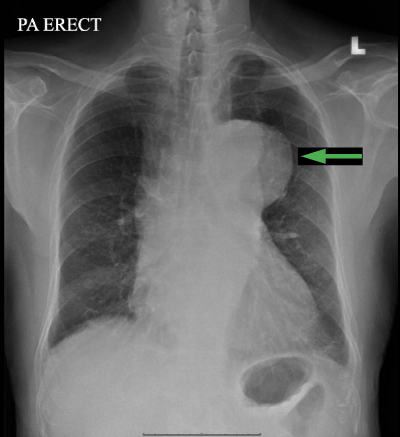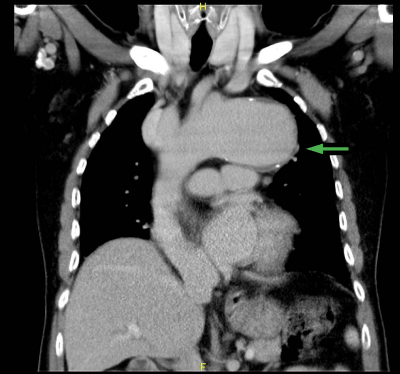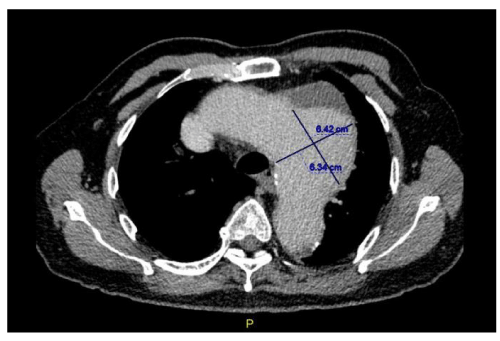Global Journal of Medical and Clinical Case Reports
Ortner’s Syndrome: A cause of unilateral vocal cord paralysis
Vanitha Palanisamy*, Kevin Suresh Doshi, Tengku Ezulia Tengku Nun Ahmad, Mohd Zulkiflee Abu Bakar and Raman Rajagopalan
Cite this as
Palanisamy V, Doshi KS, Tengku Nun Ahmad TE, Abu Bakar MZ, Rajagopalan R (2017) Ortner’s Syndrome: A rare cause of unilateral vocal cord paralysis. Glob J Medical Clin Case Rep 4(3): 069-071. DOI: 10.17352/2455-5282.000051Ortner’s syndrome is rare syndrome characterised by hoarseness of voice due to recurrent laryngeal nerve involvement in cardiovascular disease.
This report presents a case of left laryngeal paralysis caused by an aortic arch aneurysm and to highlight the importance of an otorhinolaryngology evaluation along with a thoracic radiologic study.
Introduction
Ortner’s syndrome, also known as cardiovocal syndrome, is a syndrome characterised by hoarseness caused by impingement of the Left Recurrent Laryngeal Nerve (LRLN) resulting from a cardiovascular disease. Only about 5% of cases has been reported in literature as a rare situation in which aneurysm causes unilateral vocal cord paralysis [1,2].
This syndrome was first described in 1897 by Nobert Ortner, an Austrian physician [3]. Ortner originally described this syndrome in association with mitral stenosis. However, now it is recognized as a complication of a number of cardiovascular diseases [4]. Painless aortic aneurysm presenting as hoarseness of voice is a rare presentation [5-7].
This report presents a case of left laryngeal paralysis caused by a great aortic arch aneurysm and to highlight the importance of an otorhinolaryngology evaluation along with a thoracic radiologic study.
Case Report
An 80-year-old man was presented to the Otorhinolaryngology clinic at University Malaya Medical Centre with complaints of hoarseness and cough during fluid intake in the past 6 months. Patient has underlying hypertension and chronic kidney disease. He was previously a chronic smoker and stopped few years ago. Patient had an episode of spontaneous pneumothorax 2 year ago which needed chest tube insertion and resolved after 1 day. Otherwise there were no other history of trauma or chest infection report. Physical examination revealed that the patient has breathy hoarse voice. The neck, cardiovascular and respiratory examination was unremarkable.
Flexible laryngoscopy revealed left vocal cord immobility in paramedian position with phonatory gap. Thoracic X-ray showed a bulge adjacent to the aortic area (Figure 1). In addition to the chest X-ray findings, computed tomography (CT) scan of the thorax was carried out to investigate extra-laryngeal causes of vocal cord palsy. CT scan showed a fusiform aneurysm in the aortic arch distal to left subclavian artery, with the widest diameter measuring 6.4cm, leading to compression of the left laryngeal nerve. No evidence of dissection or rupture was discovered (Figure 2,3).
Patient was referred to Cardiothoracic Surgery team for review. An elective aneurysm repair was discussed with the patient. The patient opted for conservative management in view of his age. Referral to swallowing team was made to aid in preventing aspiration.
Discussion
Hoarseness is a symptom of laryngeal diseases caused by interference to normal opposition of vocal cords. In cases of upper respiratory infection or voice abuse, hoarseness may be self-limiting [5]. Vocal cord paralysis in adults are commonly caused by trauma, surgery, malignant neoplasms and metastatic brain injuries, inflammatory conditions like tuberculosis and idiopathic [1]. The LRLN is mainly vulnerable to lesions due to its intimate anatomic relation to the aortic arch, left lung apex, trachea, oesophagus, left pulmonary artery, and mediastinal lymph nodes [8].
Hoarseness has also been reported as a possible complication from other cardiovascular diseases, including pulmonary hypertension, interatrial communication, and patency of the arterial canal [9-11].
Hoarseness as the only feature of thoracic aortic aneurysm is a rare entity, occurring in approximately 5% of cases1. However, it is assigned to the compression of this nerve, which can get hooked around the ligament arteriosus between the pulmonary artery and the aortic aneurysm. The enlarging lumen of the aneurysm may directly compress on the adjacent nerve, causing neuronal injury of the RLN manifesting in neurological symptoms, as in our case, the patient’s presenting symptom was hoarseness and not chest or back pain.
Recurrent laryngeal nerve palsy with unilateral paresis of the vocal cords may involve lesions in the chest, skull base, or neck. Direct laryngoscopy of the patients will reveal left vocal cord palsy. Lesions in the aortopulmonary window may be difficult to identify or characterize on chest x-ray, therefore, contrast enhanced CT scan may be used to further evaluate these lesions. Chest x-ray showed a suspicious marked prominence of the aortic knob, which was confirmed by CT to be an aortic arch aneurysm. Thoracic aneurysms occur most commonly in the sixth and seventh decades of life, and males are affected approximately 2-4 times more commonly than females, as in our case the patient was an 80year-old male [5].
Hypertension is an important risk factor, being present in over 60% of patients, our patient was chronically hypertensive [12]. The morphology of the aortic aneurysms can be either saccular, fusiform or dissecting. Early diagnosis of syndrome may be helpful in starting immediate treatment to restore vocal cord function and prevent permanent damage to the left recurrent laryngeal nerve. However the decision of intervention also depends on the patients general condition and age, as in our case patient opted for conservative management.
Aortic aneurysm is a life-threatening condition if it ruptures. The reversal of Ortner’s syndrome after aneurysm repair has been described [4]. Stoob demonstrated for the first time the reversal of Ortner’s syndrome after endoluminal aneurysm repair [13]. After the release of the RLN compression, it is possible to regain the mobility of the vocal cord. If the vocal cord paralysis persists, or if the patient has symptoms of aspiration, then medialisation of the vocal cord can be undertaken.
Conclusion
In conclusion, Ortner’s Syndrome is uncommon. In patients presented with hoarseness of voice without any obvious neck or lung pathology, thoracic aortic aneurysm need to be considered as a possible cause. Early referral to otorhinolaryngology and cardiothoracic team is mandatory to ensure the optimal management of the patient.
- Yuan SM (2012) Hoarseness subsequent to cardiovascular surgery, intervention, maneuver and endotracheal intubation: the socalled iatrogenic Ortner’s (cardiovocal) syndrome. Cardiol J 19: 560–566. Link: https://goo.gl/pP5qBK
- Ohki M (2012) Thoracic saccular aortic aneurysm presenting with recurrent laryngeal nerve palsy prior to aneurysm rupture: a prodrome of thoracic aneurysm rupture? Case Rep Otolaryngol 2012: 367873. Link: https://goo.gl/gGEGE8
- Ortner NI (1897) Recurrent laryngeal nerve paralysis due to mitral valve stenosis. Weiner Klinische Wochenschrift 10: 753-755.
- Norly S, Noorizan Y, Ros’aini P (2013) Thoracic Aortic Aneurysm Presenting as Vocal Cord Paralysis. International Medical Journal Malaysia 12: 67-68. Link: https://goo.gl/od9pcW
- Elzamzamy UA, Joharjy IA (2007) Thoracic aortic aneurysm presenting only as vocal cord paralysis. Neurosciences 12: 245- 248. Link: https://goo.gl/RtkZBo
- Khan IA, Wattanasauwan N, Ansari AW (1999) Painless aortic dissection presenting as hoarseness of voice: cardiovocal syndrome: Ortner's syndrome. Am J Emerg Med 17: 361-363. Link: https://goo.gl/JGwWj3
- Lee SI, Pyun SB, Jang DH (2006) Dysphagia and hoarseness associated with painless aortic dissection: a rare case of cardiovocal syndrome. Dysphagia 21: 129-132. Link: https://goo.gl/X9S8tM
- Alves Zangirolami AC, Oliveira FV, Tepedino MS (2015) Ortner’s Syndrome: Secondary LaryngealParalysis Caused by a Great Thoracic Aorta Aneurysm. Int Arch Otorhinolaryngol 19: 180–182. Link: https://goo.gl/99ek7V
- Anuar K, Baki MM, Sani A, Husin Athar PPS (2011) Hoarseness Due to Cardiovascular Disease: Two Cases of Cardiovocal Syndrome. Philipp J Otolaryngol Head Neck Surg 26: 31-33. Link: https://goo.gl/TKc67f
- Sengupta A, Dubey SP, Chaudhuri D, Sinha AK, Chakravarti P (1998) Ortner’s syndrome revisited. J Laryngol Otol 112: 377-379. Link: https://goo.gl/TnULce
- Zaharudin I, Azizi ZA (2016) Thoracic Aortic Aneurysm as A Cause of Ortner’s Syndrome - A Case Series. Med J Malaysia 71: 139-141. Link: https://goo.gl/yLVRJ1
- Teixido MT, Leonetti JP (1990) Recurrent laryngeal nerve paralysis associated with thoracic aortic aneurysm. Otolaryngol Head Neck Surg 102: 140-144. Link: https://goo.gl/PufJBs
- Stoob K, Alkadhi H, Lachat M, Wildermuth S, Pfammatter T (2004) Resolution of hoarseness after endovascular repair of thoracic aortic aneurysm: a case of Ortner’s syndrome. Ann Otol Rhinol Laryngol 113: 43-45. Link: https://goo.gl/Q5vGfg

Article Alerts
Subscribe to our articles alerts and stay tuned.
 This work is licensed under a Creative Commons Attribution 4.0 International License.
This work is licensed under a Creative Commons Attribution 4.0 International License.



 Save to Mendeley
Save to Mendeley
